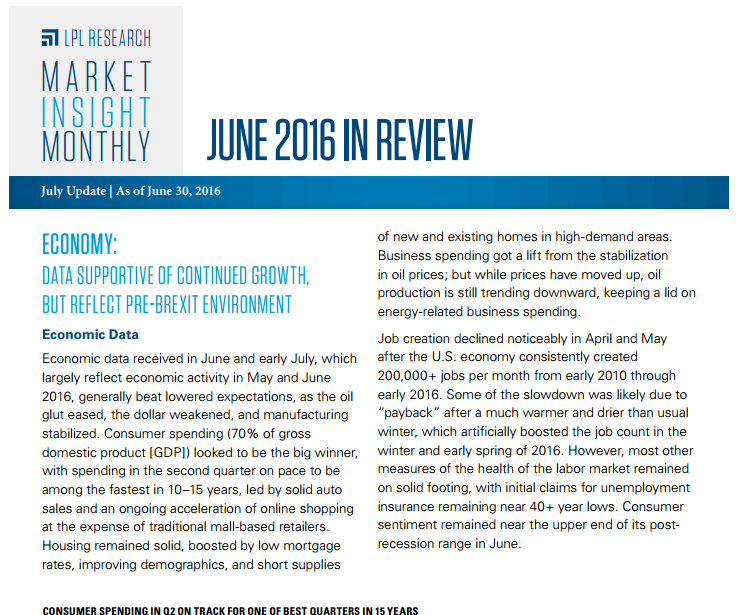ECONOMY: DATA SUPPORTIVE OF CONTINUED GROWTH, BUT REFLECT PRE-BREXIT ENVIRONMENT
Economic Data
Economic data received in June and early July, which largely reflect economic activity in May and June 2016, generally beat lowered expectations, as the oil glut eased, the dollar weakened, and manufacturing stabilized. Consumer spending (70% of gross domestic product [GDP]) looked to be the big winner, with spending in the second quarter on pace to be among the fastest in 10–15 years, led by solid auto sales and an ongoing acceleration of online shopping at the expense of traditional mall-based retailers. Housing remained solid, boosted by low mortgage rates, improving demographics, and short supplies of new and existing homes in high-demand areas. Business spending got a lift from the stabilization in oil prices; but while prices have moved up, oil production is still trending downward, keeping a lid on energy-related business spending.
Job creation declined noticeably in April and May after the U.S. economy consistently created 200,000+ jobs per month from early 2010 through early 2016. Some of the slowdown was likely due to “payback” after a much warmer and drier than usual winter, which artificially boosted the job count in the winter and early spring of 2016. However, most other measures of the health of the labor market remained on solid footing, with initial claims for unemployment insurance remaining near 40+ year lows. Consumer sentiment remained near the upper end of its postrecession range in June.

The one caveat to the better tone of U.S. economic data released in June is that they reflect economic activity and consumer behavior prior to the June 23, 2016, “Brexit” referendum in the United Kingdom (U.K) to leave the European Union (EU). Economic reports won’t fully reflect the impact of the U.K.’s unexpected decision to leave the EU until the data for July and August are released in August and September. This delay will raise the significance, for financial markets, of the weekly reports on initial jobless claims, consumer sentiment, retail sales, and others. We don’t expect the Brexit vote to have a large impact on U.S. growth in the second half of 2016, but a stronger dollar, slower exports to the EU and U.K., and tighter financial conditions in the U.S. are all possible outcomes of the Brexit vote’s impact on the U.S. economy.
Prior to the June 23 Brexit vote, real-time and leading indicators continued to point to a declining chance of a recession in the next year, but the odds of a recession in the U.S. nudged higher in the final week of June, mainly as a result of a potential spillover from the financial turmoil in Europe to the U.S. financial markets and economy. The data released that referenced the pre-Brexit time frame, including The Conference Board’s Leading Economic Index (LEI), an aggregate of leading indicators, and the level of initial claims suggest low odds of a recession based solely on the economic data. Meanwhile, the Atlanta Federal Reserve’s (Fed) real-time GDP forecasting model saw its second quarter GDP forecast rise from 1.8% at the end of April to 2.9% at the end of June, driven primarily by forecast improvements from consumer goods expenditures and homebuilding.

Central Banks
As was the case with the economic data in June, the actions of central banks in June should be viewed both pre- and post-Brexit. Even before the Brexit vote, the Fed’s June Federal Open Market Committee (FOMC) meeting, along with Fed Chair Janet Yellen’s testimony to Congress on monetary policy and the economic outlook, suggested that the Fed was prepared to be cautious in raising rates this year. Post-Brexit, central banks generally followed the crisis playbook that has become all too common since 2007, promising to provide liquidity to the system to absorb the shock to the financial system. The Fed’s next meeting is in late July; and while the Bank of England is likely to cut rates at its next meeting in mid-July, the Bank of Japan, the European Central Bank, and the Fed are likely in “wait and see” mode.
Click here to download a PDF of this report.
IMPORTANT DISCLOSURES
The economic forecasts set forth in the presentation may not develop as predicted. The opinions voiced in this material are for general information only and are not intended to provide or be construed as providing specific investment advice or recommendations for any individual security. There is no assurance that the techniques and strategies discussed are suitable for all investors or will yield positive outcomes. The purchase of certain securities may be required to affect some of the strategies.
This research material has been prepared by LPL Financial LLC.
To the extent you are receiving investment advice from a separately registered independent investment advisor, please note that LPL Financial LLC is not an affiliate of and makes no representation with respect to such entity.
Not FDIC or NCUA/NCUSIF Insured | No Bank or Credit Union Guarantee | May Lose Value | Not Guaranteed by Any Government Agency | Not a Bank/Credit Union Deposit
Tracking #1-514147 (Exp. 07/17)
